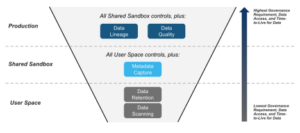The ability to manage data well is central to any organization’s mission. At Capital One, we’re dedicated to changing banking for good and empowering our business users to access quality data at scale and in real-time is critical to this transformative work. How did we make this possible? By making an upfront investment in building a comprehensive set of rules governing data access and activity. Our robust data governance strategy enables us to make grounded decisions that help drive business success.
An effective and efficient data governance program can lead to stronger policy adherence, more accurate decision-making, improved data quality, lower costs, and streamlined user access to necessary data. Failing to implement a solid governance program can lead to serious handicaps within an organization. Gartner analysts estimate that, through 2025, eight out of ten digital businesses fail to scale because of an outdated approach to data governance.
Over the years, Capital One has learned a great deal about designing and implementing adaptive data governance strategies. I’d like to share some of these learnings to help other companies build a sound data governance playbook, regardless of size, industry, or where they are on their data journey.
Focus on the benefits, not the work
Convincing executives to invest in a robust data governance program can be challenging. It can often be seen as a cost center with a major risk of under-resourcing the teams necessary to support the effort. You can tackle these two challenges by focusing everyone’s attention on the outcomes and long-term benefits of governance, not on the work itself.
It’s easy to paint a picture of the long-term benefits. Capital One, for example, has thousands of analysts. If we build the right governance across our data sets, those analysts should be able to quickly find the data that they need, access it with the right permissions, know what it means, trust what’s there, and know how to use it. Through better self-service, we can avoid thousands of analyst information requests per data set if they don’t have to rely on a central team for access. Instead, the governance policies are embedded within the self-service platform, leading to savings in time and efficiency.
Set a big vision, but be specific
Paint a holistic vision for what governance will look like across the organization and be specific
about it. Tell decision-makers, data publishers, and data consumers exactly how you will implement the new governance practices and provide a roadmap that stakeholders can easily follow to get buy-in. Start communicating early to get feedback from the right people. This early feedback is critical to alleviate bottlenecks before you start and provides valuable information to improve your strategy.
Establish policies first, then bring in the data
One behavior to avoid is bringing in all your data sets and creating policies around them. It’s important to establish your governance policies first. Governance is not something you want to do after the fact. It’s easier to adhere to policies when guidelines exist. Remember, governance is not about rules; it’s an ongoing practice. If you build a flexible framework and establish governance policies that can adapt, you will be able to adjust how you govern your data as industry requirements and parameters shift.
Practice “sloped governance”
Experience has also taught us that having the same governance standards and controls across different data sets can slow down analysts. Because not all data is created equal, a sloped governance model saves time and resources by increasing the access and security level for each ascending level of data.
For example, private spaces for data analysts can have the lowest data governance requirements since this data is not shared with anyone and has very minimal time to live. Shared sandboxes have stricter controls on data retention and scanning and restrictions on metadata capture. A production environment would have the highest governance requirements, with broader access restrictions and disclosures on data lineage and quality in order to provide the highest level of traceability and confidence.

Keep humans in the loop
A standard bottleneck organizations face in their quest to reach an “ideal state” of effective data governance is central teams lacking the capacity to implement real programs. Leaders can help remove these barriers and remain well-managed by making teams accountable for their data. This can be done by moving to a federated model with central policies and central tooling.
Humans are the most critical pillar of success when it comes to data governance. Dedicate time to training and learning new technologies. Ensure your users know how to be successful. Even better, make it easy for them by creating your governance self-service. Build the tools so users can easily catalog data, request access, and find what they need. With proper tools comes automation. Try to innovate once and then get to the next challenge. We want our people to innovate on an ever-evolving set of challenges, never resting on their laurels.
Anyone embarking on a data governance program should embrace that this is a difficult, yet rewarding journey. The most important piece of advice I can offer is not to give up. Stick to your framework and never compromise your goals. Good data governance can be the secret weapon that makes your organization more successful.
It’s not easy to bring new processes or technologies to an organization. You’re asking many people in your organization — analysts, risk teams, data scientists, etc. — to change how they work. It takes time, but the investment will pay off richly for your business and its people.
Nagender Gurram is senior director, Software Engineering at Capital One Software
The post Building an Effective Data Governance Strategy appeared first on SD Times.
from SD Times https://ift.tt/gfVQPHI
Comments
Post a Comment